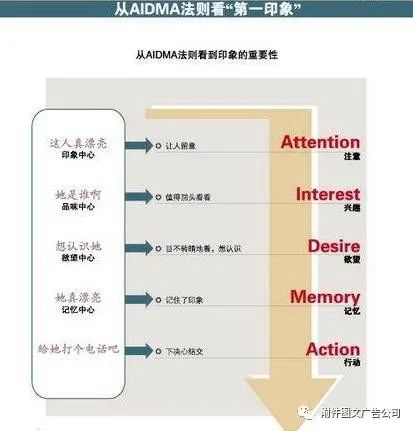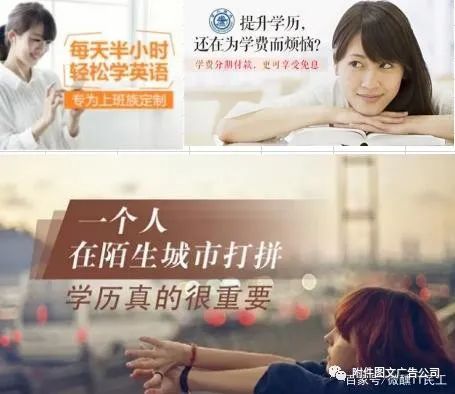Revelation! The three secrets of information flow advertising ideas

For information flow ad optimizers,
Poor click-through rate for pictures /video footage.... I don't know how to do it.
So how do you get people to convert with great ad ideas?
Before we talk about this, let's go to the ADMA Law and the AISAS Law of the Advertising Communication Model under Cop:

AidMA's Law is a representative consumer psychology model proposed by American advertiser E.S. Lewis, which summarizes the psychological process of consumers when buying goods.
The process is to first the consumer, notice the advertisement, then feel interested (in-terest) and read on, and then create the desire to buy and try (desire). Then remember that the content of the ad ends up in action. This kind of advertising has the effect to guide the psychological change that the consumer produces, called THEMA law.
You can try to recall, if you are a consumer is also will do the same psychological process?

"Attention - Interest - Desire - Memory - Action" is referred to simply as AIDS.
A:Attention(Attention) - Ads must first get the audience's attention, such as contrasting colors, enlarged text, etc.
I:Interest(Interest) - Content needs to generate interest in information interaction with the audience based on attention.
D:Desire(arouse desire) - to stimulate their demand for the utility of the product. For example, to promote the house, to take customers to visit the house. At the entrance to the restaurant, a refined sample of all the colors and aromas is displayed, so that the customer can feel the charm of the goods, which can arouse his desire to buy.
M:memory(Leaving a memory) - repeatedly stimulate their nerves, so that it subtly combines demand with products, consumers have a high desire for a commodity when the general goods will be more than three, the most impressive in memory is its most want to make a deal with the party.
A:Action(Buy Action) - to arouse user consumption and truly re-gain the benefits and effects of the product.
The law mainly exists in the past history, information is a lot of asymmetry, consumers know little about the product, access to information channels are relatively single. Therefore, the whole consumption process is relatively single, is a one-way funnel conversion. However, in the internet age, the explanation of this theory can not accurately profile some typical characteristics of consumers.
In 2005, Japan's Qualcomm Group proposed a new model of consumer behavior analysis based on changes in consumer life patterns in the age of Internet and wireless applications: the AISAS Law.
The first two stages of AISAS are the same as the ADDMA model, but in the third stage S is Search, i.e. actively searching for information, the fourth stage is A, i.e. the purchase is achieved, and the last stage S is Share, which shares the purchase and others. In the new marketing law, the emergence of two web-specific "search" -search and share points to the importance of search and share in the Internet age, rather than indoctrinating users with the idea of one-way, fully reflecting the impact and change of the Internet on people's lifestyles and consumer behavior.

Understanding the law of advertising communication model, let's go on to say: the three secrets of information flow advertising creativity.
First, the choice of pictures should follow the "four principles"
The right image is one of the key elements of advertising success, and the four principles we need to follow when selecting footage images are:The composition is concise, the text is clear, the whole coordinates, the main and the sub-clear.

1. The proportion of characters in creative material is very high, there is a strong sense of generation is also more eye-catching
2. The scene reflects what kind of consumption experience the user environment can bring to the consumer
The structure of the diagram that is commonly used in infoflow advertising ideas:

The left and right structures are simple and easy to use, with the highest frequency of use, the upper and lower structures are clearly divided and easier to arouse resonance, and the overall coordination of the center structure is high, not very good control.
Second, "heart-to-heart" direct hit the user pain point
The greatest role of the text is to guide and influence the user, in order to achieve the best results, do not write the text is not painful, must be a word, hit the user's needs pain point. The paper can be divided into three directions:Stimulate demand, meet demand, stimulate decision-making.

(1) Stimulate demand - stimulate different emotions of the user
Motivates self-improvement and motivates users to self-charge/have low academic qualifications, such as low wages and difficulties in promotion
(2) To meet demand - reduce time costs, economic costs
This direction of the paper, mostly applicable to academic training and vocational education target users are mostly full-time office workers, they do not have complete time to study, so the paper should highlight the premise that can not affect the work of learning.
(3) Stimulate decision-making - simple and direct, promote purchase
This direction of the paper, mostly applicable to promotional activities, highlighting price concessions, to facilitate the purchase.

Third, guide the transformation
After the product selling point is clear, all we have to do is use the product to meet the needs of the audience, so that the audience perceives the value of the product. As shown in the image below: "Use it, parcel, cash on delivery" guide click to see the details
Video content material is divided into 3 steps: 3 to 5S beginning, start storytelling, final transformation.
3 to 5S start:The role of the front 3 to 5S is to catch the user's eyeball with the content, so that the user is attracted by the content
Start telling a story:After catching the eye, we're going to start telling stories, which means we're going to start creating scene content
In the end, it's still a conversion:After guiding the final transformation of this piece and making the selling point of the product clear, all we have to do is use the product to meet the needs of the audience, so that the audience perceives the value of the product.

Finally, let's summarize a few key points:
1. Understand the Learned Advertising Communication AIMDA And AISAS Laws
2. The four principles of creativity: concise composition, clear text, overall coordination, the main and sub-clear.
3. Three directions: to stimulate demand, to meet demand, to stimulate decision-making
4. Explain the selling point of the product clearly and guide the transformation
The above, that is, to share with you today, pictures, paper different creative choices, I hope you look at the combination of their own industry analysis and judgment, summed up suitable for your own set of promotion methods is the most important.
Go to "Discovery" - "Take a look" browse "Friends are watching"